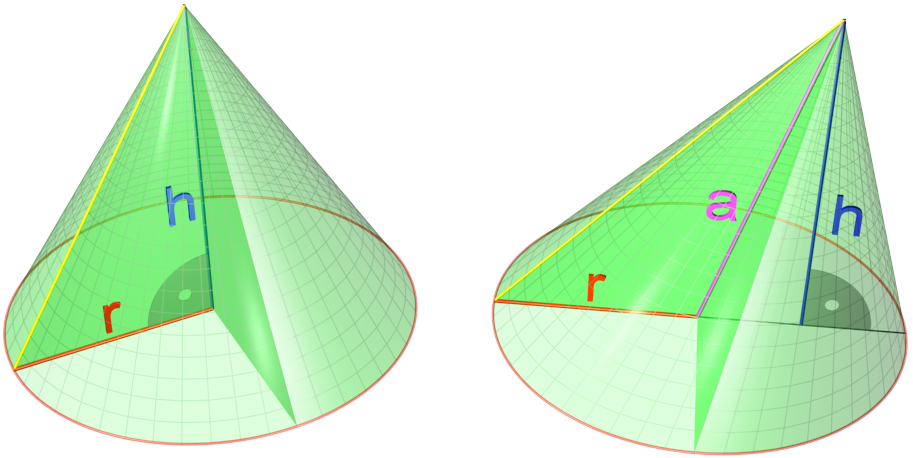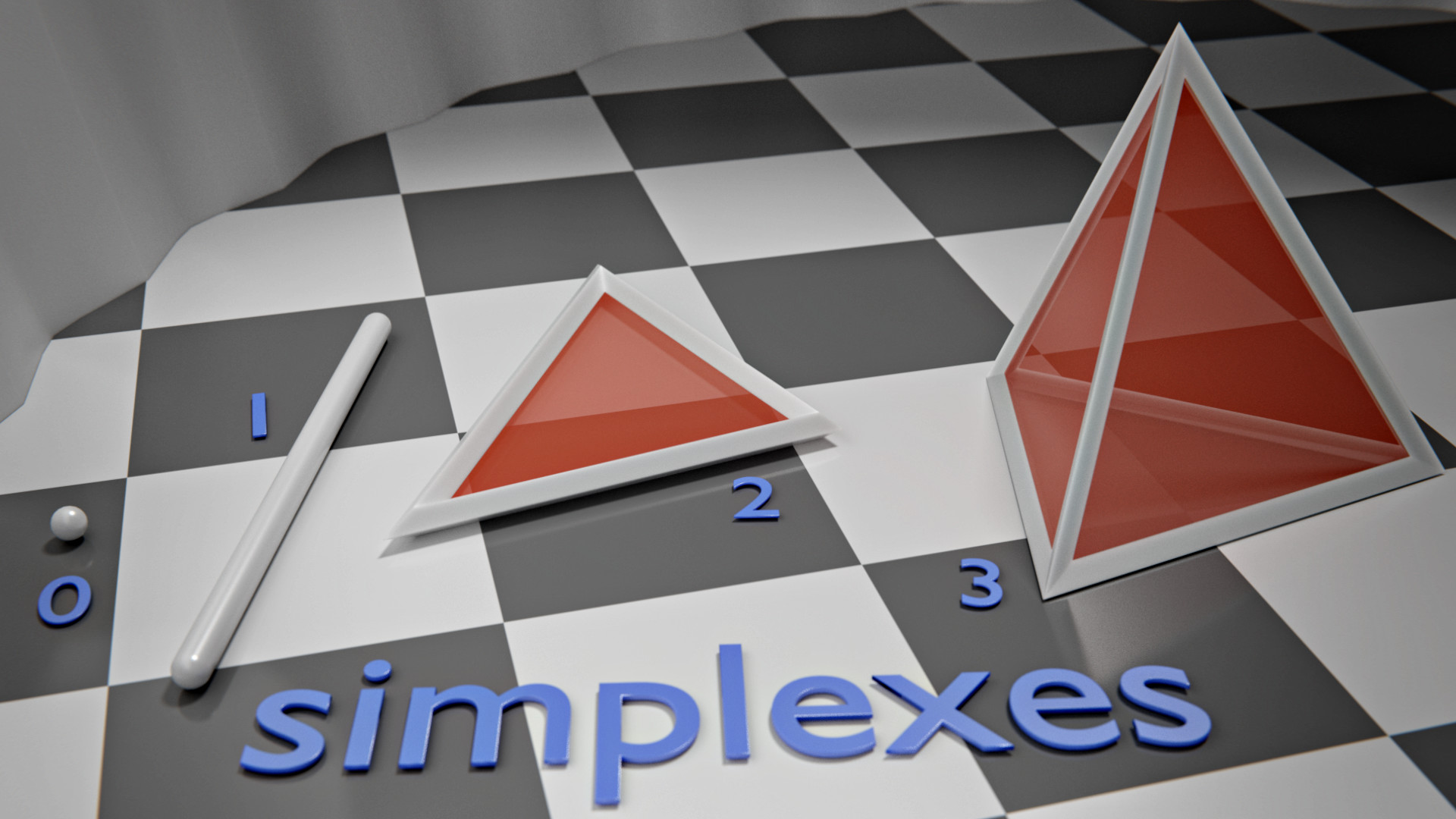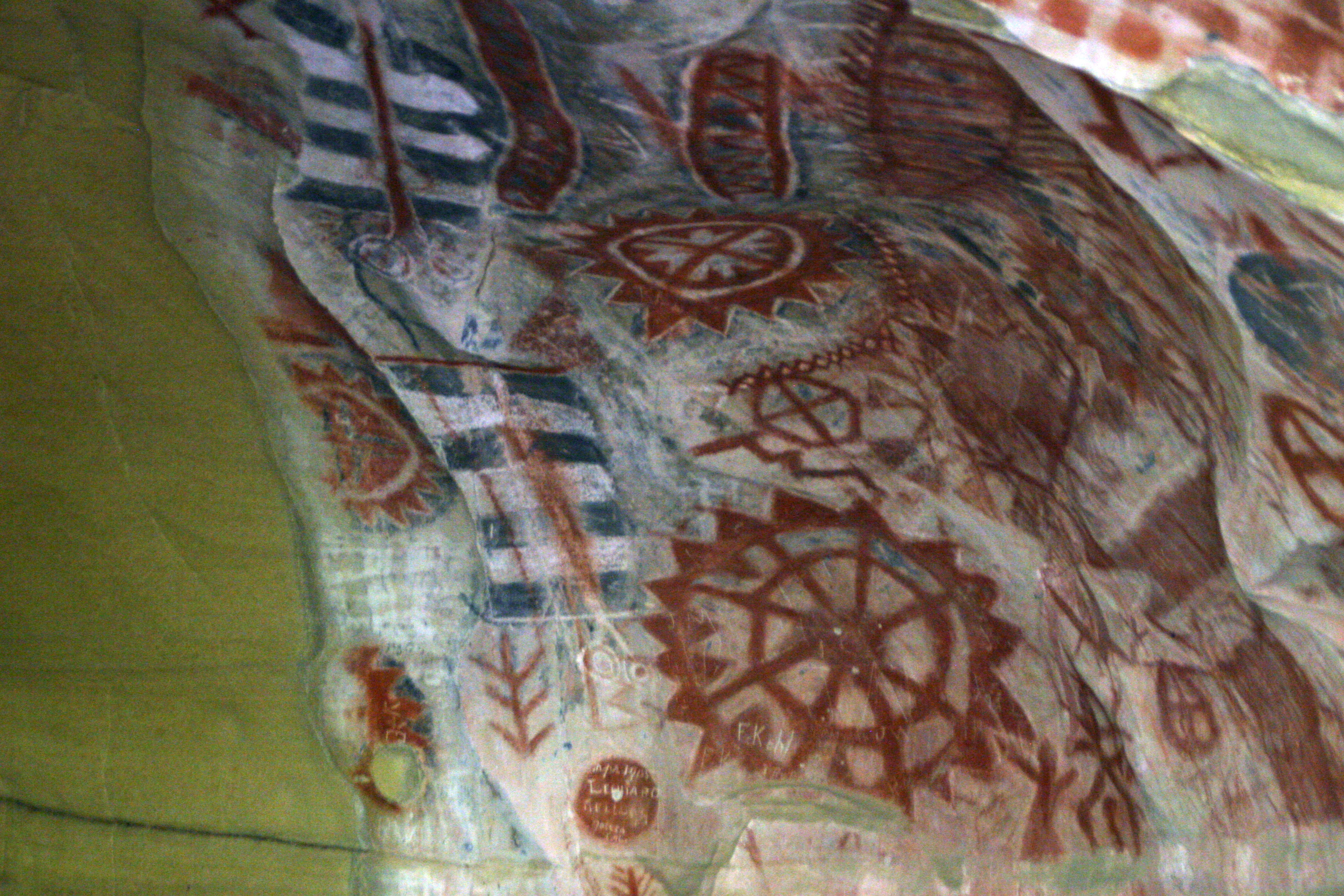|
Cone (topology)
In topology, especially algebraic topology, the cone of a topological space X is intuitively obtained by stretching ''X'' into a cylinder and then collapsing one of its end faces to a point. The cone of X is denoted by CX or by \operatorname(X). Definitions Formally, the cone of ''X'' is defined as: :CX = (X \times ,1\cup_p v\ =\ \varinjlim \bigl( (X \times ,1 \hookleftarrow (X\times \) \xrightarrow v\bigr), where v is a point (called the vertex of the cone) and p is the projection to that point. In other words, it is the result of attaching the cylinder X \times ,1/math> by its face X\times\ to a point v along the projection p: \bigl( X\times\ \bigr)\to v. If X is a non-empty compact subspace of Euclidean space, the cone on X is homeomorphic to the union of segments from X to any fixed point v \not\in X such that these segments intersect only in v itself. That is, the topological cone agrees with the geometric cone for compact spaces when the latter is defined. H ... [...More Info...] [...Related Items...] OR: [Wikipedia] [Google] [Baidu] |
Cone
In geometry, a cone is a three-dimensional figure that tapers smoothly from a flat base (typically a circle) to a point not contained in the base, called the '' apex'' or '' vertex''. A cone is formed by a set of line segments, half-lines, or lines connecting a common point, the apex, to all of the points on a base. In the case of line segments, the cone does not extend beyond the base, while in the case of half-lines, it extends infinitely far. In the case of lines, the cone extends infinitely far in both directions from the apex, in which case it is sometimes called a ''double cone''. Each of the two halves of a double cone split at the apex is called a ''nappe''. Depending on the author, the base may be restricted to a circle, any one-dimensional quadratic form in the plane, any closed one-dimensional figure, or any of the above plus all the enclosed points. If the enclosed points are included in the base, the cone is a solid object; otherwise it is an open surface ... [...More Info...] [...Related Items...] OR: [Wikipedia] [Google] [Baidu] |
Triangle
A triangle is a polygon with three corners and three sides, one of the basic shapes in geometry. The corners, also called ''vertices'', are zero-dimensional points while the sides connecting them, also called ''edges'', are one-dimensional line segments. A triangle has three internal angles, each one bounded by a pair of adjacent edges; the sum of angles of a triangle always equals a straight angle (180 degrees or π radians). The triangle is a plane figure and its interior is a planar region. Sometimes an arbitrary edge is chosen to be the ''base'', in which case the opposite vertex is called the ''apex''; the shortest segment between the base and apex is the ''height''. The area of a triangle equals one-half the product of height and base length. In Euclidean geometry, any two points determine a unique line segment situated within a unique straight line, and any three points that do not all lie on the same straight line determine a unique triangle situated w ... [...More Info...] [...Related Items...] OR: [Wikipedia] [Google] [Baidu] |
Embedding
In mathematics, an embedding (or imbedding) is one instance of some mathematical structure contained within another instance, such as a group (mathematics), group that is a subgroup. When some object X is said to be embedded in another object Y, the embedding is given by some Injective function, injective and structure-preserving map f:X\rightarrow Y. The precise meaning of "structure-preserving" depends on the kind of mathematical structure of which X and Y are instances. In the terminology of category theory, a structure-preserving map is called a morphism. The fact that a map f:X\rightarrow Y is an embedding is often indicated by the use of a "hooked arrow" (); thus: f : X \hookrightarrow Y. (On the other hand, this notation is sometimes reserved for inclusion maps.) Given X and Y, several different embeddings of X in Y may be possible. In many cases of interest there is a standard (or "canonical") embedding, like those of the natural numbers in the integers, the integers i ... [...More Info...] [...Related Items...] OR: [Wikipedia] [Google] [Baidu] |
Homotopy
In topology, two continuous functions from one topological space to another are called homotopic (from and ) if one can be "continuously deformed" into the other, such a deformation being called a homotopy ( ; ) between the two functions. A notable use of homotopy is the definition of homotopy groups and cohomotopy groups, important invariants in algebraic topology. In practice, there are technical difficulties in using homotopies with certain spaces. Algebraic topologists work with compactly generated spaces, CW complexes, or spectra. Formal definition Formally, a homotopy between two continuous functions ''f'' and ''g'' from a topological space ''X'' to a topological space ''Y'' is defined to be a continuous function H: X \times ,1\to Y from the product of the space ''X'' with the unit interval , 1to ''Y'' such that H(x,0) = f(x) and H(x,1) = g(x) for all x \in X. If we think of the second parameter of ''H'' as time then ''H'' describes a ''continu ... [...More Info...] [...Related Items...] OR: [Wikipedia] [Google] [Baidu] |
Contractible
In mathematics, a topological space ''X'' is contractible if the identity map on ''X'' is null-homotopic, i.e. if it is homotopic to some constant map. Intuitively, a contractible space is one that can be continuously shrunk to a point within that space. Properties A contractible space is precisely one with the homotopy type of a point. It follows that all the homotopy groups of a contractible space are trivial. Therefore any space with a nontrivial homotopy group cannot be contractible. Similarly, since singular homology is a homotopy invariant, the reduced homology groups of a contractible space are all trivial. For a nonempty topological space ''X'' the following are all equivalent: *''X'' is contractible (i.e. the identity map is null-homotopic). *''X'' is homotopy equivalent to a one-point space. *''X'' deformation retracts onto a point. (However, there exist contractible spaces which do not ''strongly'' deformation retract to a point.) *For any path-connected space ... [...More Info...] [...Related Items...] OR: [Wikipedia] [Google] [Baidu] |
Path-connected Space
In topology and related branches of mathematics, a connected space is a topological space that cannot be represented as the union (set theory), union of two or more disjoint set, disjoint Empty set, non-empty open (topology), open subsets. Connectedness is one of the principal topological properties that distinguish topological spaces. A subset of a topological space X is a if it is a connected space when viewed as a Subspace topology, subspace of X. Some related but stronger conditions are #Path connectedness, path connected, Simply connected space, simply connected, and N-connected space, n-connected. Another related notion is Locally connected space, locally connected, which neither implies nor follows from connectedness. Formal definition A topological space X is said to be if it is the union of two disjoint non-empty open sets. Otherwise, X is said to be connected. A subset of a topological space is said to be connected if it is connected under its subspace topology. So ... [...More Info...] [...Related Items...] OR: [Wikipedia] [Google] [Baidu] |
Simplex
In geometry, a simplex (plural: simplexes or simplices) is a generalization of the notion of a triangle or tetrahedron to arbitrary dimensions. The simplex is so-named because it represents the simplest possible polytope in any given dimension. For example, * a 0-dimensional simplex is a point, * a 1-dimensional simplex is a line segment, * a 2-dimensional simplex is a triangle, * a 3-dimensional simplex is a tetrahedron, and * a 4-dimensional simplex is a 5-cell. Specifically, a -simplex is a -dimensional polytope that is the convex hull of its vertices. More formally, suppose the points u_0, \dots, u_k are affinely independent, which means that the vectors u_1 - u_0,\dots, u_k-u_0 are linearly independent. Then, the simplex determined by them is the set of points C = \left\. A regular simplex is a simplex that is also a regular polytope. A regular -simplex may be constructed from a regular -simplex by connecting a new vertex to all original vertices by the common ... [...More Info...] [...Related Items...] OR: [Wikipedia] [Google] [Baidu] |
N-ball
In mathematics, a ball is the solid figure bounded by a ''sphere''; it is also called a solid sphere. It may be a closed ball (including the boundary points that constitute the sphere) or an open ball (excluding them). These concepts are defined not only in three-dimensional Euclidean space but also for lower and higher dimensions, and for metric spaces in general. A ''ball'' in dimensions is called a hyperball or -ball and is bounded by a ''hypersphere'' or ()-sphere. Thus, for example, a ball in the Euclidean plane is the same thing as a disk, the planar region bounded by a circle. In Euclidean 3-space, a ball is taken to be the region of space bounded by a 2-dimensional sphere. In a one-dimensional space, a ball is a line segment. In other contexts, such as in Euclidean geometry and informal use, ''sphere'' is sometimes used to mean ''ball''. In the field of topology the closed n-dimensional ball is often denoted as B^n or D^n while the open n-dimensional ball is \oper ... [...More Info...] [...Related Items...] OR: [Wikipedia] [Google] [Baidu] |
Ball (mathematics)
In mathematics, a ball is the solid figure bounded by a ''sphere''; it is also called a solid sphere. It may be a closed ball (including the boundary points that constitute the sphere) or an open ball (excluding them). These concepts are defined not only in three-dimensional Euclidean space but also for lower and higher dimensions, and for metric spaces in general. A ''ball'' in dimensions is called a hyperball or -ball and is bounded by a ''hypersphere'' or ()-sphere. Thus, for example, a ball in the Euclidean plane is the same thing as a disk, the planar region bounded by a circle. In Euclidean 3-space, a ball is taken to be the region of space bounded by a 2-dimensional sphere. In a one-dimensional space, a ball is a line segment. In other contexts, such as in Euclidean geometry and informal use, ''sphere'' is sometimes used to mean ''ball''. In the field of topology the closed n-dimensional ball is often denoted as B^n or D^n while the open n-dimensional ball is \o ... [...More Info...] [...Related Items...] OR: [Wikipedia] [Google] [Baidu] |
N-sphere
In mathematics, an -sphere or hypersphere is an - dimensional generalization of the -dimensional circle and -dimensional sphere to any non-negative integer . The circle is considered 1-dimensional and the sphere 2-dimensional because a point within them has one and two degrees of freedom respectively. However, the typical embedding of the 1-dimensional circle is in 2-dimensional space, the 2-dimensional sphere is usually depicted embedded in 3-dimensional space, and a general -sphere is embedded in an -dimensional space. The term ''hyper''sphere is commonly used to distinguish spheres of dimension which are thus embedded in a space of dimension , which means that they cannot be easily visualized. The -sphere is the setting for -dimensional spherical geometry. Considered extrinsically, as a hypersurface embedded in -dimensional Euclidean space, an -sphere is the locus of points at equal distance (the ''radius'') from a given '' center'' point. Its interior, consisting of ... [...More Info...] [...Related Items...] OR: [Wikipedia] [Google] [Baidu] |
Disc (mathematics)
In geometry, a disk ( also spelled disc) is the region in a plane bounded by a circle. A disk is said to be ''closed'' if it contains the circle that constitutes its boundary, and ''open'' if it does not. For a radius r, an open disk is usually denoted as D_r, and a closed disk is \overline. However in the field of topology the closed disk is usually denoted as D^2, while the open disk is \operatorname D^2. Formulas In Cartesian coordinates, the ''open disk'' with center (a, b) and radius ''R'' is given by the formula D = \, while the ''closed disk'' with the same center and radius is given by \overline = \. The area of a closed or open disk of radius ''R'' is π''R''2 (see area of a disk). Properties The disk has circular symmetry. The open disk and the closed disk are not topologically equivalent (that is, they are not homeomorphic), as they have different topological properties from each other. For instance, every closed disk is compact whereas every open disk is ... [...More Info...] [...Related Items...] OR: [Wikipedia] [Google] [Baidu] |
Circle
A circle is a shape consisting of all point (geometry), points in a plane (mathematics), plane that are at a given distance from a given point, the Centre (geometry), centre. The distance between any point of the circle and the centre is called the radius. The length of a line segment connecting two points on the circle and passing through the centre is called the diameter. A circle bounds a region of the plane called a Disk (mathematics), disc. The circle has been known since before the beginning of recorded history. Natural circles are common, such as the full moon or a slice of round fruit. The circle is the basis for the wheel, which, with related inventions such as gears, makes much of modern machinery possible. In mathematics, the study of the circle has helped inspire the development of geometry, astronomy and calculus. Terminology * Annulus (mathematics), Annulus: a ring-shaped object, the region bounded by two concentric circles. * Circular arc, Arc: any Connected ... [...More Info...] [...Related Items...] OR: [Wikipedia] [Google] [Baidu] |





